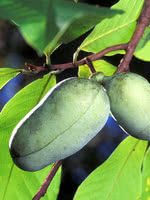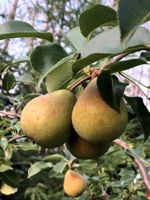Mon-Fri 9am - 5pm Mountain time
Pawpaw vs Beedle Pear
Asimina triloba
Pyrus Beedle
SOLD OUT
The Pawpaw tree produces delicious, sweet fruit with a unique banana-mango flavor. These oblong fruits start yellowish-green and mature to a dark brown in the fall. It is best to leave them on the tree until ripe, as they do not ripen well once picked. Pawpaws can be enjoyed fresh, in baking, or in ice cream.
Pawpaws produce the largest native fruit in North America. They typically grow as a small understory tree or large shrub on wooded slopes, in ravines, and along stream banks. They often spread through root suckers, forming dense thickets over time.
For fruit production to occur more than one genetically different Pawpaw tree is required. Our Pawpaw seedlings are grown from seed so they are all genetically different.
Note: Avoid eating the seeds and skin of the Pawpaw fruit as they can cause stomach pain for some individuals. Contact with the skin of the fruit can also result in skin irritation, so it is recommended to wear gloves during harvest. Plant this tree once. Due to its large tap root transplanting is not recommended.
Beedle Pear is sweet, soft, and juicy with no astringency making it great for fresh eating. They typically ripen on the tree in early September. The medium-sized pears keep relatively well when compared to other varieties. For most years it is a reliable producer on the prairies.
The Beedle Pear is a cold hardy pear with Canadian roots. John Beedle discovered it on a city boulevard in St. Albert, Alberta.
For fruit production, another pear variety is required for cross-pollination. Can be paired with Krazulya Pear or Ussurian Pear.

